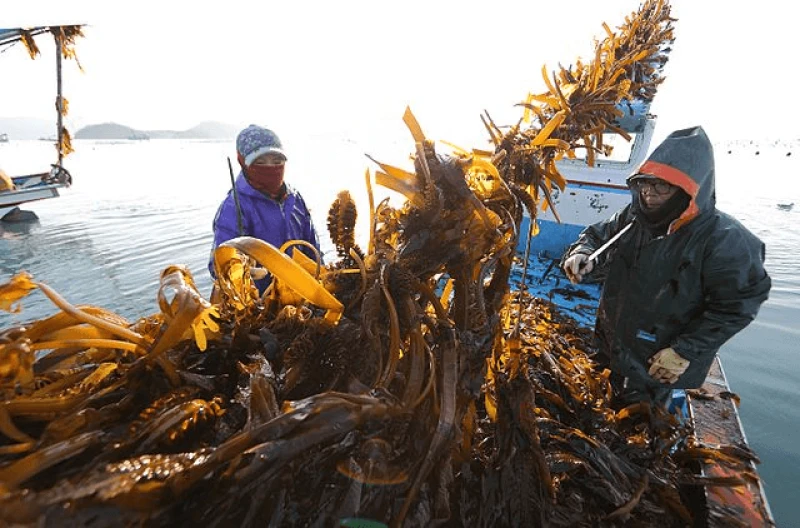Post-apocalyptic farming? How seaweed could help us avert starvation during a nuclear winter
Post-apocalyptic farming? How seaweed could help us avert starvation during a nuclear winter


A nuclear war would plunge our planet into a deep nuclear winter. In the worst-case scenario, a nuclear exchange… could eject up to 165 million tons (150 million metric tons) of soot into Earth’s atmosphere, reducing surface temperatures by 16 degrees Fahrenheit (9 degrees Celsius) and sending global calorie production plummeting by as much as 90%.
But in a new study, scientists found that within nine to 14 months of nuclear war, vast arrays of kelp grown on ropes in the Gulf of Mexico and across the Eastern seaboard could be harvested — helping to keep up to 1.2 billion humans fed.
At their fullest extent, the seaweed farms would replace 15% of the food currently consumed by humans, while also providing 50% of current biofuel production and 10% of animal feed. The researchers published their findings Jan. 9 in the journal Earth’s Future.
The scientists’ model revealed that kelp farms wouldn’t just survive but thrive and expand as surface temperatures dropped. This is because colder air would force surface water to sink more, increasing the circulation of nutrient-rich water up from the depths to replace it.
As the iodine found in seaweed can be toxic to humans at high quantities, the uses for kelp grown in farms would primarily be indirect, the researchers said. But by using it to feed animals and produce biofuels, it would free up the surviving arable land for other crops.
This is an excerpt. Read the original post here

 | Videos | More... |

Video: Nuclear energy will destroy us? Global warming is an existential threat? Chemicals are massacring bees? Donate to the Green Industrial Complex!
 | Bees & Pollinators | More... |

GLP podcast: Science journalism is a mess. Here’s how to fix it

Mosquito massacre: Can we safely tackle malaria with a CRISPR gene drive?

Are we facing an ‘Insect Apocalypse’ caused by ‘intensive, industrial’ farming and agricultural chemicals? The media say yes; Science says ‘no’
 | Infographics | More... |

Infographic: Global regulatory and health research agencies on whether glyphosate causes cancer
 | GMO FAQs | More... |

Why is there controversy over GMO foods but not GMO drugs?

How are GMOs labeled around the world?

How does genetic engineering differ from conventional breeding?
 | GLP Profiles | More... |

Alex Jones: Right-wing conspiracy theorist stokes fear of GMOs, pesticides to sell ‘health supplements’




 Viewpoint — Fact checking MAHA mythmakers: How wellness influencers and RFK, Jr. undermine American science and health
Viewpoint — Fact checking MAHA mythmakers: How wellness influencers and RFK, Jr. undermine American science and health Viewpoint: Video — Big Solar is gobbling up productive agricultural land and hurting farmers yet providing little energy or sustainabilty gains
Viewpoint: Video — Big Solar is gobbling up productive agricultural land and hurting farmers yet providing little energy or sustainabilty gains Fighting deforestation with CO2: Biotechnology breakthrough creates sustainable palm oil alternative for cosmetics
Fighting deforestation with CO2: Biotechnology breakthrough creates sustainable palm oil alternative for cosmetics Trust issues: What happens when therapists use ChatGPT?
Trust issues: What happens when therapists use ChatGPT? 30-year-old tomato line shows genetic resistance to devastating virus
30-year-old tomato line shows genetic resistance to devastating virus California, Washington, Oregon forge immunization alliance to safeguard vaccine access against federal undermining
California, Washington, Oregon forge immunization alliance to safeguard vaccine access against federal undermining The free-range chicken dilemma: Better for birds, but with substantial costs
The free-range chicken dilemma: Better for birds, but with substantial costs ‘You have to treat the brain first’: Rethinking chronic pain with Sanjay Gupta
‘You have to treat the brain first’: Rethinking chronic pain with Sanjay Gupta
